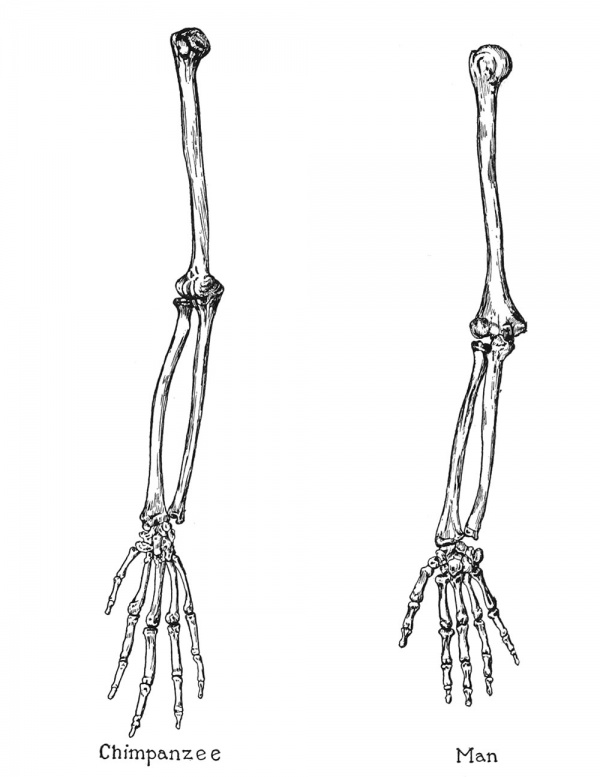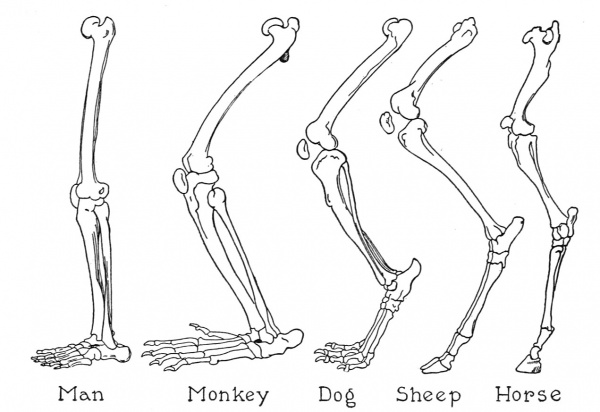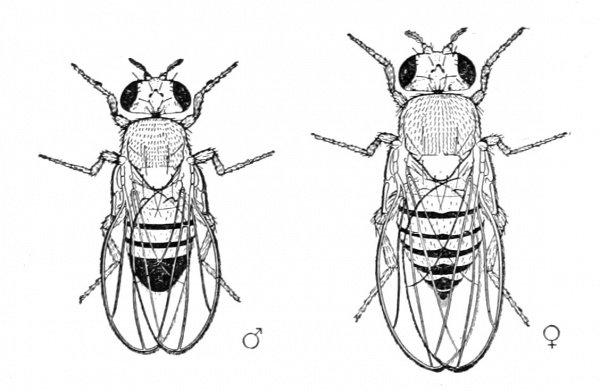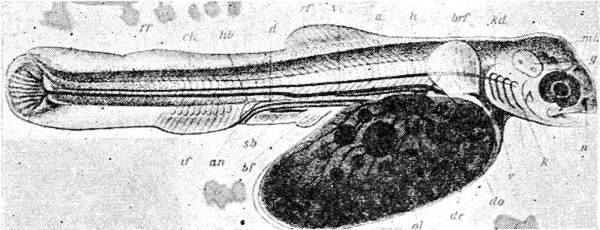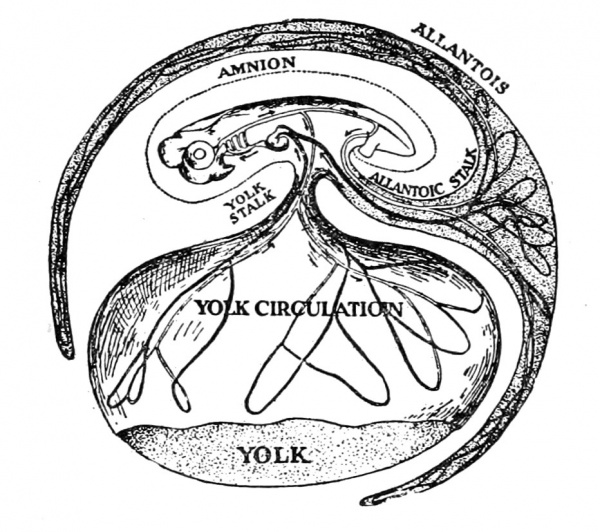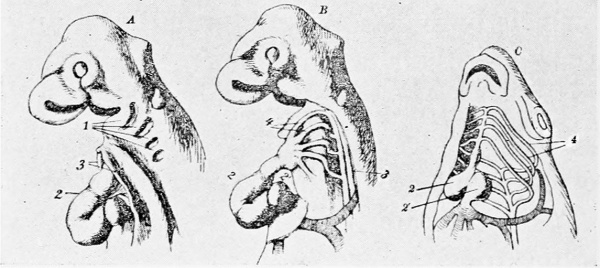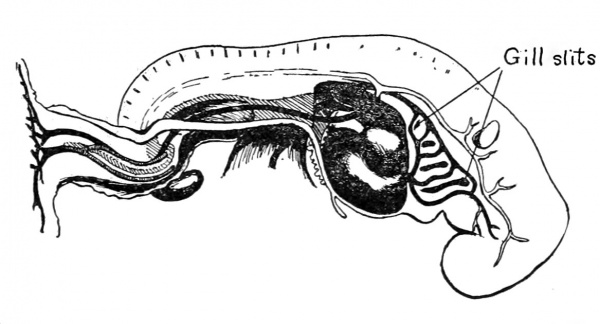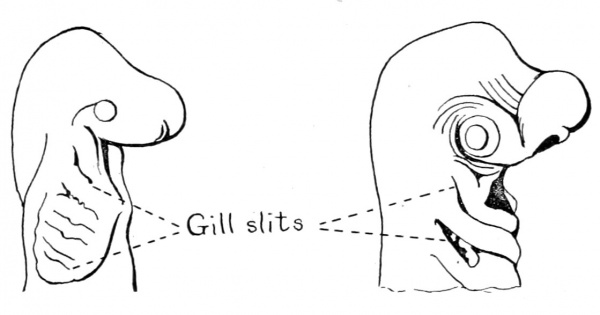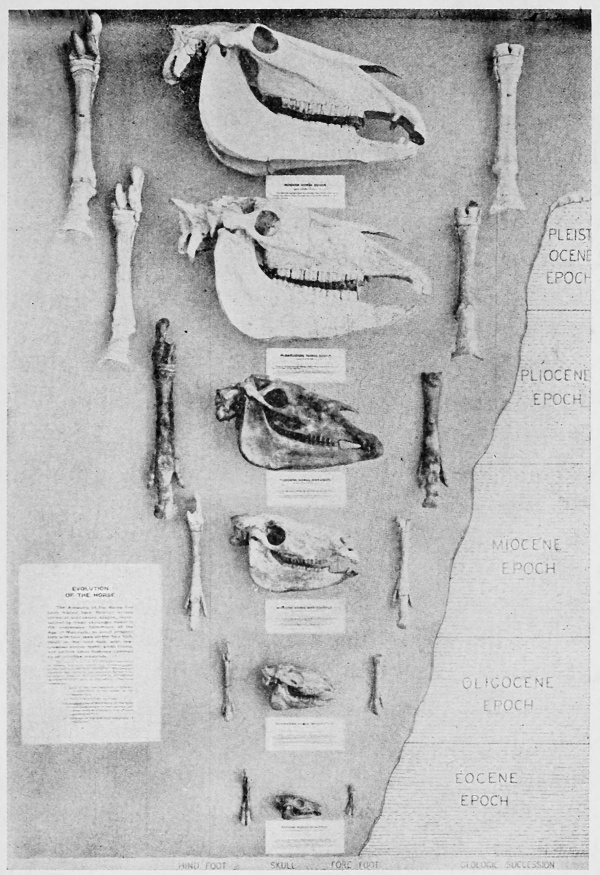Book - Evolution and Genetics 3
| Embryology - 27 Apr 2024 |
|---|
| Google Translate - select your language from the list shown below (this will open a new external page) |
|
العربية | català | 中文 | 中國傳統的 | français | Deutsche | עִברִית | हिंदी | bahasa Indonesia | italiano | 日本語 | 한국어 | မြန်မာ | Pilipino | Polskie | português | ਪੰਜਾਬੀ ਦੇ | Română | русский | Español | Swahili | Svensk | ไทย | Türkçe | اردو | ייִדיש | Tiếng Việt These external translations are automated and may not be accurate. (More? About Translations) |
Morgan TH. Evolution and Genetics (1925). Princeton University Press.
| Historic Disclaimer - information about historic embryology pages |
|---|
| Pages where the terms "Historic" (textbooks, papers, people, recommendations) appear on this site, and sections within pages where this disclaimer appears, indicate that the content and scientific understanding are specific to the time of publication. This means that while some scientific descriptions are still accurate, the terminology and interpretation of the developmental mechanisms reflect the understanding at the time of original publication and those of the preceding periods, these terms, interpretations and recommendations may not reflect our current scientific understanding. (More? Embryology History | Historic Embryology Papers) |
Chapter 3 The Evidence For Organic Evolution
Four branches of study have furnished the evidence of organic evolution: Comparative anatomy; Embryology; Paleontology; and Experimental Breeding or Genetics.
The Evidence from Comparative Anatomy
When we study animals and plants we find that they can be arranged in groups according to their resemblances. This is the basis of comparative anatomy, which is only an accurate study of facts that are superficially obvious to everyone.
The groups are based not on a single difference, but on a very large number of resemblances. Let us take for example the group of vertebrates.
The hand and the arm of man are similar to the hand and arm of the ape (fig. 4) . The legs of man, monkey, dog, sheep, and the horse are made up of similar bones (fig, 5) . The same parts are found in the leg of the lizard, the frog, and, even though less certainly, in the fins of fishes. Comparison does not end here. We find similarities in the skull and backbones of these same animals ; in the brain ; in the digestive system; in the heart and blood vessels; in the muscles.
Each of these systems is very complex, but the same general arrangement is found in all. Anyone familiar with the evidence will, I think, probably reach the conclusion either that these animals have been created on some preconceived plan, or else that they have some other bond that unites them ; for we find it difficult to believe that such complex, yet similar, things could have arisen independently.
Fig. 4. Arm of chimpanzee and of man, drawn to scale. (After Haeckel)
Fig. 5. Legs of five mammals, drawn to scale, to show homologous parts. (After Leconte, from Romanea.)
Because we can often arrange the series of structures in a line extending from the very simple to the more complex, we are still to become unduly impressed by this fact and conclude that if we found the complete series we should find all the intermediate steps and that they have arisen in the order of their complexity. For example, there have appeared in our cultures of the vinegar fly, Drosophila melanogaster (fig. 6) over four hundred new types that breed true. Each has arisen independently and suddenly. Every part of the body has been affected by one or another of these mutations. Many different kinds of changes have taken place in the wings and several of these involve the size of the wings. If we arrange the latter arbitrarily in the order of their size there will be an almost complete series beginning with normal wings and ending with those of apterous flies. Several of these types are represented in figure 7. The order in which these mutations occurred bears no relation to their size ; each originated independently from the wild type.
Fig. 6. Male and female vinegar fly, Drosophila melanogaster.
Mutations have occurred involving the pigmentation of the body and wings. The head and thorax of the wild Drosophila melanogaster are grayish yellow, the abdomen is banded with yellow and black, and the wings are gray. There have appeared in our cultures several kinds of darker types ranging to almost black flies and to lighter types that are pale yellow. If put in line a series may be made from the darkest flies at one end to the light yellow flies at the other. These types, with the fluctuations that occur within each type, furnish a complete series of gradations ; vet historically they have arisen independently of each other.
Fig. 7. Mutants of Drosophila melanogaster, arranged in order of size of wings; rr, cut,; 6, beaded; c, stumpy; c/, another stumpy; e, vestigial; j, apterous.
Many changes in eye color have appeared. As many as fifty or more races differing in eye color are now maintained in our cultures. Some of them are so similar that they can scarcely be separated from each other. It is easily possible beginning with the darkest eye color, sepia, which is deep brown, to pick out a perfectly graded series ending with pure white eyes. But such a serial arrangement would give a totally false idea of the way the different types have arisen; and any conclusion based on the existence of such a series might very well be entirely erroneous, for the fact that such a series exists bears no relation to the order in which its members have appeared.
Suppose that evolution "in the open" had taken place in the same way, by means of discontinuous variation. What value then would the evidence from comparative anatomy have in so far as it is based on a continuous series of variants of any organ?
No one familiar with the entire evidence will doubt for a moment that these four hundred races of Drosophila belong to the same species and have had a common origin, for while they may differ mainly in one thing; they are extremely alike in a hundred other things, and in the general relation of the parts to each other.
It is in this sense that the evidence from comparative anatomy can be used, I think, as an argument for evolution. It is the resemblances that the animals or plants in any group have in common that is the basis for such a conclusion ; it is not because we can arrange any j)articular variations in a continuous series. In other words, our inference concerning the common descent of two or more species is based on the totality of such resemblances that still remain in large part after each change has taken place. In this sense the argument froom comparative anatomy, while not a demonstration, furnishes circumstantial evidence too strong to be disregarded.
The Evidence from Embryology
In passing from the egg to the adult the individual goes through a series of changes. In the course of this development we see not only the beginnings of the organs that gradually enlarge and change into those of the adult animal, but also see some organs appear and later disappear before the adult stage is reached. We find, moreover, that the young sometimes resemble in a most striking wav the adult stage of groups that we place lower in the scale of evolution.
Many years before Darwin advanced his theory of evolution through natural selection, the resemblance of the young of higher animals to the adults of lower animals had attracted the attention of zoologists and various views, often very naive, had been advanced to account for the resemblance. Among these speculations there was one practically identical with that adopted by Darwin and the post Darwinians, namely that the higher animals repeat in their development the adult stages of lower animals. Later this view became one of the cornerstones of the theory of organic evolution. It reached its climax in the writings of Haeckel, and I think I may add without exaggeration that for twenty-five years it furnished the chief inspiration of the school of descriptive embryology. Today it is taught in many textbooks of biology. Haeckel called this interpretation the Biogenetic Law. The parallel between the historical development of antlers of deer (fig. 8) and their postnatal development from year to year (fig. 9) is most striking. Historically we may suppose that the development was due to the appearance of hereditary variations in the germ material. At the present time, the stages in their development are closely correlated with age, size, and especially with the yearly increase in the internal secretion of the testes ; for, after castration the antlers no longer develop. In living deer all the hereditary factors that appeared in the past are present at each stage, but the extent to which the antlers develop depends on the physiological conditions mentioned above. In other words, while there is a close relation in both cases between the hereditary factors present, the causes that led to the development of the more complicated stages in the past (the accumulation of hereditary factors) are different from the causes that, at present, bring about a similar sequence as the individual gets older.
Fig. 8. Fossil deer antlers. The first two to the left are from the mid-eosine; the third is from the upper miocene; the fourth is from the pliocene, as is also the fifth figure. The figure to the right is from the "forest-bed of Norfolk." (After RoTrwnes.)
Fig. 9. Antlers of stag showing successive additions of brandies in successive years. (After Romanes.)
It was early recognized that many embryonic stages could not possibly represent ancestral animals. A young fish with a huge yolk sac attached (fig. 10) could scarcely ever have led a free life as an adult individual. Such stages were interpreted, however, as embryonic additions to the original ancestral type. The embryo bad done something on its own account.
In some animals the young have structures that attach them to the mother, as does the placenta of the mammals. In other cases the young develop membranes about themselves — like the amnion of the chick (fig. 11) and mammal — that would have shut off an adult animal from all intercourse with the outside world. Hundreds of such embryonic structures are known. These were explained as embryonic adaptations and hence falsifications of the ancestral records.
Fig. 10. Young trout, six days after hatching. (After Zieyler.)
Fig. 11. Diagram of chick, showing relations of amnion, allantois, and yolk. (After Wilder.)
At the end of the last century Weismann injected a new idea into our views concerning the origin of variations. He urged that variations are germinal,
i.e., they first appear in the egg and the sperm as
changes that later bring about modifications in the
individual. The idea has been fruitful and is generally accepted by most biologists today. It means
that the offspring of a pair of animals are not affected by the structure or the activities of their parents, but the gerni material is the unmodified stream
from which both the parent and the young have
arisen. Hence their resemblance. Now, it has been
found that a variation arising in the germ material,
no matter what its cause, may affect any stage in
the development of the next individuals that arise
from it. There is no reason to suppose that such a
change produces a new character that always sticks
itself, as it were, on to the end of the old series. This
idea of germinal variation therefore carried with it
the death of the older conception of evolution by
superposition.
In more recent times another idea has become current, mainly due to the work of Bateson and of de Vries — the idea that variations are discontinuous. Such a conception does not fall easily into line with the statement of the biogenetic "law"; for actual experience with discontinuous variation has taught us that new characters that arise do not add themselves to the end of the line of already existing characters but if they involve adult characters they change them without, as it were, passing through and beyond them.
I venture to think that these new ideas and this new evidence have played havoc with the biogenetic "law." Nevertheless, there is an interpretation of the facts that is entirely compatible with the theory of evolution. Let me illustrate this by an example.
Fig. 12. Diagram of head of chick, A and B, showing gill slits and aortic arches; and head of fish, C, showing aortic arches. (After Hesse.)
The embryos of the chick (fig. 12) and of man (fig. 13) possess at an early stage in their development gill slits on the sides of the neck like those of fishes. No one familiar with the relations of the parts will for a moment doubt that the gill slits of these embryos and of the fish represent the same structures. When we look further into the matter we find that young fish also possess gill slits (fig. 14) — even in young stages in their development. Is it not then more probable that the mammal and bird possess this stage in their development simply because it has never been lost? Is not this a more reasonable view than to suppose that the gill slits of the embryos of the higher forms represent the adult gill slits of the fish that in some mysterious Avay have been pushed back into the embryo of the bird?
Fig. 13. Human embryo, showing gill slits and aortic arches. (After His, from Marshall.)
Fig. 14. Side views of head of embryo shark, showing gill slits. (After Sedgwick.)
Many similar examples con Id be given. All can be interpreted as embryonic survivals rather than as phyletic contractions. Not one of them calls for the latter interpretation.
The stud}" of the cleavage pattern of the segmenting egg furnishes the most convincing evidence that a different explanation from the one stated in the biogenetic law is the more probable explanation.
It has been found that the cleavage pattern has the same general arrangement in the early stages of flat worms, annelids and molluscs (fig. 15). Obviously these stages have never been adult ancestors, and obviouslv if their resemblance has any historical meaning at all, it is that each group has retained the same general plan of cleavage, possessed by their common ancestor.
Accepting this view, does the evidence from embrvologv favor the theory of evolution? I think that it does very strongly. The embryos of the mammal, bird, and lizard have gill slits today because gill slits were present in the embryos of their common ancestors. There is no other view that explains so well their presence in the higher forms.
It may be asked whether this is not all that the "biogenetic law"claims. Has not the old conclusion been reached in a roundabout wav? I think not. To my mind there is a wide difference between the old statement that the higher animals living today have the original adult stages telescoped into their embryos, and the statement that the resemblance between certain characters in the embryos of higher animals and corresponding stages in the embryos of lower animals is most plausibly explained by the assumption that they have descended from the same ancestors, and that their common structures are embryonic survivals.
Fig. 15. Cleavage stages of four types of eggs; a, Planarian; 6, Annelid; c, Mollusc (Crepidula); d. Mollusc (Unio).
The Evidence from Paleontology
The direct evidence furnished by fossil remains is by all odds the strongest evidence that we have in favor of organic evolution. Paleontology holds the incomparable position of being able to point directly to fossil remains showing that the animals and plants living in past times are connected with those living at the present time, often through an unbroken series of stages (fig. 16). Paleontology has triumphed over the weakness of the evidence, which Darwin admitted was serious, by filling in many of the missing links.
Paleontology has been criticised on the ground that it cannot pretend to show the actual ancestors of living forms, because, if in the past genera and species were as abundant and as diverse as we find them at present, it is very improbable that the bones of any individual that happened to be ]3reserved are the bones of just that species that took part in the evolution. Paleontolooists freelv admit that in many cases this is probably true, but even then the evidence is still, I think, just as valuable and in exactly the same sense as is the evidence from comparative anatomy. It suffices that there lived in the past a particular "group" of animals that had many points in common with those that preceded them and with those that came later. Whether these are the actual ancestors, or not, does not so much matter ; for, the view that, from such a group of species, the later species have been derived is far more probable than any other view that has been proposed.
Fig. 16. Evolution of the horse, showing the changes in the skull and in the bones of the legs. (After Matthews.)
With this unrivalled material and splendid series of gradations, paleontology has constructed many stages in the past history of the globe. But paleontologists have sometimes gone beyond this descriptive phase of the subject and have attempted to formulate the "causes," "laws" and "principles" that have led to the development of their series. It has even been claimed that paleontologists are in a much better position than are zoologists to discover such principles, because they know both the beginning and the end of the evolutionary series. The reply is obvious. In his sweeping and poetic vision the paleontologist may fail completely to find out the nature of the pigments that have gone into the painting of his picture, and he may confuse a familiarity with the different views he has enjoyed of the canvas, with a knowledge of how the painting was done.
When the modern student of variation and heredity — the geneticist — looks over the different continuous" series, from which certain "laws" and principles" have been deduced, he is struck by two facts : that the gaps, in some cases, are enormous as compared with the single changes with which he is familiar, and (what is more important) that they involve numerous parts in many wavs. Since the paleontologist does not know, and from the nature of the case cannot know whether the differences are due to one change or to a thousand he cannot with any certainty tell anything about the hereditary units which haye made the process of eyolution possible. Without this knowledge there can be no satisfactory understanding of the origin of new hereditary yariations through which eyolution is possible.
The Evidence from Genetics
In recent years a study of the origin of new characters has led to the discovery that sudden changes appear at times in the germinal elements — changes that haye an effect on one or more characters of the organism. The ^^rocess by which the change takes place is called mutation, and the new kind of indiyidual it produces is called a mutant. The mutants breed true to the new type. How far, and in what sense, the occurrence of mutants suffices to supply the material for eyolution in animals and plants is one of the important biological problems of today.
While in a strict sense genetics deals only with the mode of transmission of the hereditary elements (the genes) from parent to offspring, the scientific study of the origin of new variations is undertaken today almost exclusively by students of genetics, and is now recognized as a part of their work. I shall include, therefore, under the "evidence from genetics" the origin of new characters by mutation.
In many groups of animals and plants new kinds of individuals have been seen to suddenly appear. The new characters that they show are transmitted to their descendants. In some cases the new characters depart widely from those of the stock from which the new individual has sprung; in other cases the departure may be very slight and pass unnoticed unless one is very familiar with the parent stock. In fact, it is owing, in large part, to a minute examination of plants and animals, that many of the new characters studied by geneticists have been discovered. So small are some of the observed changes that they are not greater than the fluctuating changes due to the environment. The inheritance of the new character, when it is as slight as this, can only be determined by a careful study of successive generations under controlled conditions both genetic and environmental. It is the realization of these requirements that has enabled genetics to make its contribution to the theory of evolution.
While it is true that most of these mutant changes have been observed in animals under domestication, or in species that have recently been brought into the laboratory, there is no evidence that they owe their appearance to cultivation or to domestication. On the contrary similar mutants have been found in wild species. Cultivated plants and domesticated animals are more familiar to us, and more carefully scrutinized, than are wild species. Hence in large part the more frequent discovery of new types in these forms.
Many, probably most, of the extreme mutant types could not compete with the native types from which they have sprung, and this has been urged as an argument against the view that mutants could furnish the materials for evolution; because, it is said, only better adapted types coidd survive that have an advantage of some sort over the parent types so that they can replace the original types, or else find a new environment to which they are better suited than were the original forms. This argument, if it could be substantiated, would be a fatal blow to the mutation theory of evolution. It calls, therefore, for careful and impartial consideration. That it is not justified is shown, I think, by the following evidence.
While it is true that many of the mutant characters that are preserved by geneticists for a study of heredity are extreme departures from the original type, these are utilized rather than smaller differences because they are easily observed and their classification readily determined. Those characters that depart little from the parent type, or are difficult to distinguish from the fluctuating variations of that type, are more difficult to study and are neglected. Hence has arisen in some quarters the erroneous idea that all mutant types are defectives and incapable of competing with the original form.
In this connection it is important to keep in mind the fact that animals and plants are extremely complex machines that are highly adapted to the conditions of life in which they live. Any change, and especially any great change in them, is far more likely to throw them out of balance with their environment than to bring to them an advantage, but it is possible, nevertheless, that some of the changes, however slight, might be beneficial, especially those that add to or diminish slightly some important character or function already present. These changes might furnish materials for evolution.
Darwin rested his case for evolution on the observed small differences that all animals and plants show. Now, while we realize today that many of these slight differences are not inherited, we also know that amongst them there are some that are inherited, and that these, so far as we know, have arisen as mutations. At present there is no evidence that will stand the test of criticism in favor of any other origin than that all known variations owe their appearance to the same process of mutation that also produces the larger differences; and, I repeat, that there is much explicit evidence to show that very small differences, that add to or subtract from characters already j)resent, do appear by mutation.
Finally there is evidence that the differences shown by individuals in nature are inherited in the same way as are the observed mutant characters of domesticated forms. While this identity in the method of inheritance may not })e a conclusive argument in itself in showing that in both cases the differences have arisen by the same process, still the probability is so strong that it would be short-sighted to reject it, when the alternative assertion that the differences in the wild form have had a different origin, has nothing to support it. These questions will come up again for further consideration, but enough has been said to show that the discovery of the way in which new characters appear and are inherited marks a distinct advance in our study of the evolutionary process.
| Historic Disclaimer - information about historic embryology pages |
|---|
| Pages where the terms "Historic" (textbooks, papers, people, recommendations) appear on this site, and sections within pages where this disclaimer appears, indicate that the content and scientific understanding are specific to the time of publication. This means that while some scientific descriptions are still accurate, the terminology and interpretation of the developmental mechanisms reflect the understanding at the time of original publication and those of the preceding periods, these terms, interpretations and recommendations may not reflect our current scientific understanding. (More? Embryology History | Historic Embryology Papers) |

